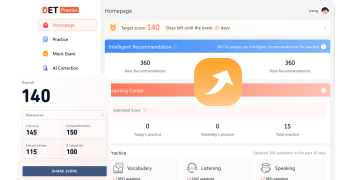Padroneggiare la sezione "Leggi, poi parla" del Duolingo English Test
Il Duolingo English Test è un modo conveniente ed economico per valutare la tua competenza in inglese online. A differenza di altri test standardizzati, il Duolingo English Test ha un formato unico che si adatta al tuo livello e alle tue abilità. Una delle parti più difficili e importanti del test è la sezione “Read, Then Speak”, dove devi parlare di un argomento per 90 secondi dopo aver letto una traccia.
In questo articolo, ti mostreremo come affrontare con successo questa sezione e migliorare i tuoi sottopunteggi di Conversazione e Produzione.
Tratteremo:
- Comprendere il formato “Read, Then Speak”
- Prepararsi a rispondere
- Strutturare la tua risposta
- Fornire la tua risposta
- Migliorare la tua risposta
- Incorporare una domanda di esempio e una risposta dimostrativa
- Consigli di pratica e risorse

Comprendere il formato “Read, Then Speak”
La sezione “Read, Then Speak” è uno dei quattro tipi di compiti di parlato nel Duolingo English Test. Ti chiede di “Parlare dell'argomento seguente per 90 secondi.”
Per questo tipo di domanda, vedrai una traccia scritta sullo schermo. Avrai 20 secondi per leggere la traccia e preparare la tua risposta. Successivamente, il test passerà automaticamente alla schermata di registrazione, dove avrai 90 secondi per parlare della tua risposta. Potrai ancora vedere la traccia mentre parli.
La traccia solitamente ti chiederà di parlare di un'esperienza personale, opinione o preferenza. Per esempio:
- Parla del tuo ristorante preferito.
- Discuti di una volta in cui hai dovuto prendere una decisione difficile.
- Descrivi un hobby che ti piace.
La traccia includerà anche alcuni punti elenco per guidare la tua risposta. Per esempio:
- Dove si trova?
- Che tipo di cibo serve?
- Quanto spesso ci vai?
- Perché è il tuo preferito?
La tua risposta sarà valutata su due sottopunteggi: Conversazione e Produzione. La Conversazione valuta quanto bene interagisci con la domanda ed esprimi le tue idee. La Produzione valuta quanto bene usi vocabolario e grammatica per comunicare in modo chiaro e accurato.
Prepararsi a Rispondere
La chiave per una risposta di successo è comprendere rapidamente la traccia e organizzare i tuoi pensieri in un breve lasso di tempo. Ecco alcune strategie per aiutarti a prepararti:
- Leggi attentamente la traccia e identifica l'argomento principale e i sottoargomenti. Per esempio, se la traccia è “Parla del tuo ristorante preferito.”, l'argomento principale è il tuo ristorante preferito, e i sottoargomenti sono dove si trova, che tipo di cibo serve, quanto spesso ci vai e perché è il tuo preferito.
- Pensa ad un esempio specifico che si riferisce all'argomento principale. Per esempio, se il tuo ristorante preferito è un ristorante tailandese vicino casa tua, pensa a un momento memorabile quando ci sei andato con i tuoi amici o familiari.
- Usa i punti elenco come guida per strutturare la tua risposta. Per esempio, puoi iniziare presentando il tuo ristorante preferito, poi parlare di ciascun punto elenco in ordine e terminare con una conclusione che riassume il tuo punto principale.
- Utilizza efficacemente i 20 secondi di tempo di preparazione. Puoi trovare alcune parole chiave per aiutarti a ricordare i tuoi punti principali. Puoi anche praticare dicendo la prima frase della tua risposta per iniziare con sicurezza.
Strutturare la Tua Risposta
Una struttura chiara e logica della risposta ti aiuterà a fornire la tua risposta in modo fluido e coerente. Ecco alcuni consigli per aiutarti a strutturare la tua risposta:
- Crea un'introduzione, un corpo e una conclusione. La tua introduzione dovrebbe presentare brevemente l'argomento principale e dichiarare il tuo punto principale. Il corpo dovrebbe sviluppare il tuo punto principale parlando di ciascun sottoargomento in dettaglio. La conclusione dovrebbe riassumere il tuo punto principale e terminare con un'osservazione finale.
- Usa parole e frasi di transizione per collegare le tue idee e frasi. Per esempio, puoi usare parole come “first”, “second”, “third”, “next”, “then”, “finally”, “also”, “however”, “for example”, “in conclusion”, ecc.
- Affronta tutte le parti della traccia. Assicurati di non saltare o ignorare nessun punto elenco. Se non hai nulla da dire su un sottoargomento, puoi riconoscerlo brevemente e passare oltre. Per esempio, puoi dire “I don’t go there very often, but when I do, I always enjoy it.”
- Rimani concentrato sull'argomento. Non andare fuori tema o nei dettagli irrilevanti. Se ti accorgi di allontanarti dall'argomento, torna al punto principale e ai punti elenco.
Fornire la Tua Risposta
La tua consegna è importante quanto il contenuto. Ecco alcune tecniche per aiutarti a fornire la tua risposta in modo chiaro e fluente:
- Parla in modo naturale e chiaro. Usa una velocità e un volume di parlata normali. Non parlare troppo velocemente o troppo lentamente, troppo forte o troppo piano. Pronuncia correttamente le parole ed evita di borbottare o biascicare.
- Usa parole e strutture varie. Non ripetere le stesse parole o frasi continuamente. Usa sinonimi, contrari o parafrasi per esprimere la stessa idea in modi diversi. Usa una gamma di vocabolario e strutture grammaticali per mostrare la tua competenza e accuratezza.
- Gestisci bene il tuo tempo. Hai 90 secondi per parlare della tua risposta, che è sufficiente per coprire la traccia e i punti elenco. Non parlare troppo a lungo o troppo poco. Se termini la tua risposta prima dello scadere del tempo, puoi aggiungere alcuni dettagli extra o esempi per elaborare il tuo punto. Se finisci il tempo, puoi concludere rapidamente la tua risposta.
- Usa intonazione e enfasi varie. Non parlare in monotono o con voce piatta. Usa cambiamenti di tono, volume e stress per trasmettere significato ed emozione. Sottolinea le parole o frasi importanti nelle tue frasi. Usa intonazioni crescenti e decrescenti per segnalare domande e affermazioni.
Migliorare la Tua Risposta
Per far risaltare la tua risposta e impressionare i valutatori, puoi usare alcune strategie per migliorare la tua risposta e dimostrare le tue abilità conversazionali. Ecco alcuni modi per farlo:
- Usa domande retoriche. Le domande retoriche sono domande che poni a te stesso o all'ascoltatore, ma non ti aspetti una risposta. Sono utilizzate per coinvolgere l'ascoltatore, esprimere i tuoi pensieri o enfatizzare un punto. Per esempio, puoi dire “Who doesn’t love Thai food, right?” or “What could be better than that?”
- Usa aneddoti o storie. Gli aneddoti o le storie sono brevi e interessanti resoconti di esperienze personali o eventi. Sono utilizzati per illustrare il tuo punto, fornire esempi o aggiungere umorismo. Per esempio, puoi dire “One time, I ordered the spiciest dish on the menu, and I regretted it so much. My mouth was on fire, and I had to drink three glasses of water to cool it down.”
- Usa opinioni o sentimenti. Le opinioni o i sentimenti sono i tuoi punti di vista personali o emozioni su un argomento. Sono utilizzati per mostrare la tua personalità, prospettiva o atteggiamento. Per esempio, puoi dire “I think Thai food is the best cuisine in the world.” or “I feel so happy and relaxed when I go to my favorite restaurant.”
Una Domanda di Esempio e una Risposta Dimostrativa
Per darti un'idea migliore di come applicare i suggerimenti e le strategie di cui abbiamo discusso, diamo un'occhiata a una domanda di esempio e una risposta dimostrativa per la sezione “Read, Then Speak”.
Domanda di Esempio:
Discuss a time when you had to make a difficult decision.
What was the situation?
What choices were available to you?
Why did you make the decision you did?
Risposta Dimostrativa:
Well, I’d say one of the toughest decisions I’ve ever had to make was figuring out where I wanted to go to college after I finished up high school. I had gotten accepted to a few different schools and it definitely wasn’t an easy choice to make.
Let’s see, first off, I should probably give you some background real quick on the different colleges I got into. There was this small liberal arts college pretty close to home that I applied to. It was a nice little school. Then there was this huge state university that was like 5 hours away – it was really big with tons of students. And last, I applied to this Ivy League school all the way on the other side of the country. I had worked really hard to get awesome grades and test scores in high school so I could have some good options to choose from.
So each school had their own pros and cons that I had to think about. The small college was nearby and I already knew some kids going there. But it didn’t have the big name like the Ivy League did. The state school was a lot more affordable but it was so big I worried I wouldn’t get enough personal attention from professors. And the Ivy League school was super prestigious, but way more competitive and expensive too.
After visiting all 3 campuses, I decided the small liberal arts college was the best option for me. I really liked the small class sizes and how tight-knit the community felt. They also gave me a great financial aid package that made it possible to afford. I knew I’d get to work closely with professors and get individualized attention there, and that was huge for me.
So in the end, I went with my gut telling me the small school was the right call. I didn’t want to pass up the chance to really get mentored and be part of a community just because the Ivy League name carried more weight. And I’m stoked with my choice – I’ve gotten to have experiences at this school I don’t think I would’ve had anywhere else. So for me, I’m happy with my decision.
Consigli di Pratica e Risorse
Il modo migliore per migliorare le tue abilità di parlato e prepararti per la sezione “Read, Then Speak” è praticare regolarmente e costantemente. Ecco alcuni metodi e risorse per aiutarti a praticare:
- Simula l'ambiente del test. Cerca di ricreare le condizioni del test reale il più possibile. Usa un computer con webcam e microfono e trova un luogo tranquillo e confortevole per sostenere il test. Imposta un timer per 20 secondi per leggere la traccia e 90 secondi per parlare della tua risposta. Registrati e ascolta la tua performance. Identifica i tuoi punti di forza e debolezza e lavora per migliorarli.
- Usa risorse online. Molte risorse online possono aiutarti a praticare le tue abilità di parlato e prepararti per il Duolingo English Test. Per esempio, puoi utilizzare il sito ufficiale DET per saperne di più sul formato del test, la valutazione e i consigli. Puoi anche utilizzare il nostro database di domande di pratica per il Duolingo English Test per familiarizzare con il test.
Fai clic qui per ulteriori Strategie di Preparazione al DET
Cerchi consigli sul DET? Scoprilo qui: https://www.detpractice.com/category/pro-test-tips/
Inizia a praticare oggi iscrivendoti gratuitamente al nostro database di domande per il DET.






